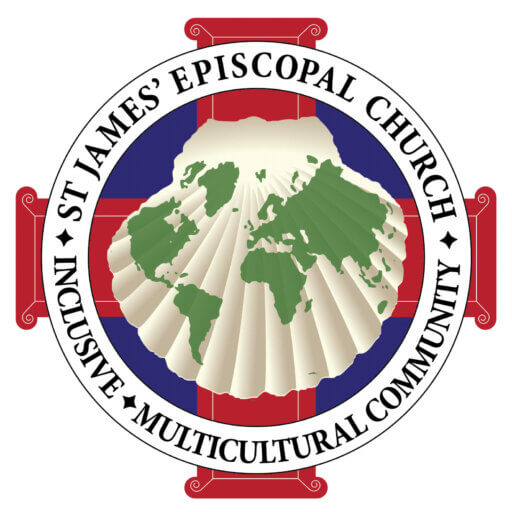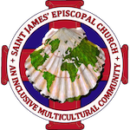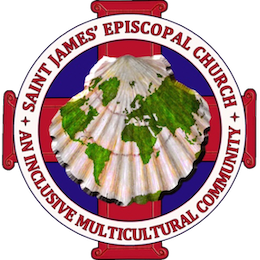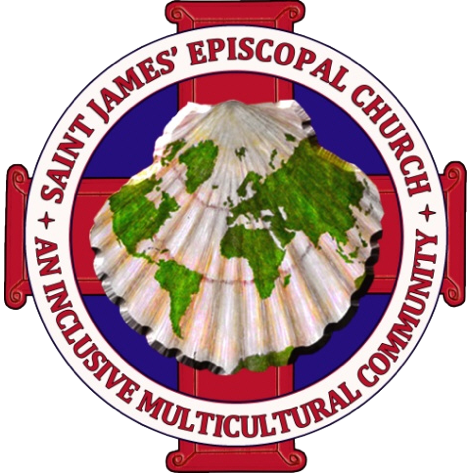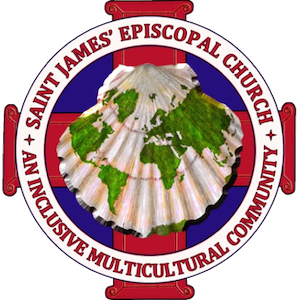Dear People of St. James’,
In 1947, something momentous happened for this congregation. For six years after its founding as the Church of the Advent, this small community of African Americans had been a community on the move. They had met together in any space they could find – in people’s homes and in other East Austin churches and community centers, anywhere where they could set a table of welcome, share a word of hope, and meet Jesus. And so it was after six years of roaming that, in 1947, this lay-led community set down roots on E. 7th St and changed its name to St. James’ Episcopal Church.
Ever since I heard this story, I have wondered why the Church of the Advent changed its name and why they chose St. James’? Apparently, I am not the first person to wonder about this. Those who have gathered up the history of this church, Ms. Ora Houston tells me, have scoured diocesan records and people’s memories looking for clues, finding no certain rationale. A couple of my predecessors have noted that the first generation of this church didn’t get super-creative with the first name, The Church of the Advent. They had started their worship together in Advent so there you go. They believed the reason for the name change was as simple as circumstance – maybe worship began in the new building around July 25, the Feast of St. James, and it felt like something new was beginning – they were planted now – and so the congregation changed its name. Others have suggested that the congregation was modeling itself after other Black congregations that had taken up the same name. Of course, that explanation runs up against the doctrine of our congregation’s uniqueness, so it has fallen out of favor.
Regardless, since 1947, St. James’ has begun services anew in two other new buildings without changing its name again, so perhaps this congregation’s identification with its patron saint’s story runs deeper than simple circumstance.
So, who is St. James? When answering this question, it is important to specify which St. James’ you are talking about because there are so many. For us, the clue is in our banner hanging up here: the shell with its imprint of the world upon it. When we refer to our St. James, we are not talking about James the Just (who is actually my favorite James) or the unfortunately named James the Less, we are, of course, referring to St. James the Great AKA St. James the Apostle AKA James, the brother of John, the son of Zebedee, and I would add: son of the audacious mother of the sons of Zebedee.
Biblical tradition has it that James, brother of John, son of Zebedee (who gets left behind in his boat), son of the mother of the sons of Zebedee (who seems to stick around at least until the crucifixion and perhaps into the Acts narrative wherein her household provides shelter for Peter and those of the Jerusalem church) – this James is one of the first disciples called by Jesus, alongside Peter and John and Andrew. He is close to Jesus, part of Jesus’ inner circle. He is so close to Jesus that Jesus takes him up the mountain to witness the Transfiguration and into the garden of Gethsemane. He is one who is close enough to Jesus to see who Jesus is in his glory and in his time of suffering and travail.
He is so close to Jesus that who James is gets revealed to us – although sometimes the picture we get of him is, well, not so Great. As with Peter, James the son of Zebedee, James Boanerges (son of Thunder) has a brash side to him, and we get to know him through the times when he gets Jesus utterly wrong. In Luke’s gospel, a Samaritan town refuses to receive Jesus, and James and John see this, and their response is, “Lord, do you want us to call fire down to consume them?” Jesus has to turn around and, depending on how you want to translate the Greek, either rebuke or exorcise them – same word. In Mark’s gospel, it’s James and John who run up to Jesus demanding to sit on his right and left when he comes into his kingdom. Maybe Matthew was so embarrassed by this that he has their mother do it instead. Either way, there is something about power that Jesus is desperately trying to teach James as Jesus heads to the cross.
“You know that the rulers of the Gentiles lord it over them, and their great ones are tyrants over them. It must not be so among you; but whoever wishes to be great among you must be your servant, and whoever wishes to be first among you must be your slave; just as the Son of Man came not to be served but to serve, and to give his life a ransom for many.”
Traditional interpretation of Acts has it that this same James is so close to Jesus that he will share Jesus’ fate – death at the hands of capricious, empire-serving powers. He will drink the cup. In Acts, yet another King Herod – not the Great – is said to lay “violent hands upon some who belonged to the church.” And Herod “has James, the brother of John, killed with the sword.”
The Bible gives us a picture of James that perhaps we can identify with – a James who is ordinary, passionate, occasionally embarrassed by his mother’s audacious straightforwardness even though clearly the apple does not fall very far from the tree there. He follows Jesus closely, and yet, even so, he gets Jesus wrong because of his own desire for power and control. It turns out that the Bible has very little to say about St. James the Great’s greatness or even about his apostleship.
But over time, it has spoken to this community here at St. James’ Austin about how the closeness to Jesus that we seek will demand that we change our understanding and our exercise of power. This was on The Rev. Arthur Calloway’s mind in the 1950s as he gathered with a flock of about 60 regulars, some of whom, like the Means family, were Black people of means and standing in the East Austin community. I have read that when The Rev. Arthur Calloway was serving on the City Council in Raleigh, North Carolina, and at St. Ambrose Episcopal Church there, he was fond of saying, “If you are gonna get close to Jesus, you have to use your power to raise up your neighbor.” This was a refrain for him.
I read Rev. Calloway’s words to the people of Raleigh, and I know that preachers tend to carry that one sermon they preach from place to place, and from call to call. And so I suspect that these words, or something like them, so well remembered by the people of the City of Raleigh and St. Ambrose, may have been carried there from his first call at St. James’ Episcopal Church, Austin. When Rev. Calloway moved to Raleigh in 1959, he was apprehensive about the direction of the city of Austin and the Episcopal Diocese of Texas – even under the leadership of Bishop John Hines – so remembers one of his parishioners, who I don’t think was just hating on Texas. Of course, he had a bit of an, out-of-the-frying-pan-and-into-the-fire, experience in Raleigh as he sought to use his power to raise up his neighbor: to fight for desegregation in education and bussing, to fight for basic services in the areas where Black people lived, to fight for affordable housing, to fight against racism in the church. He was part of the “Raleigh Round Table Gang”, a group of leaders who would gather and strategize about how to push the work of Civil Rights forward in their community. Where could they do a sit-in? Who could they have apply for a position? How could they make change to raise up their neighbors? And they didn’t just talk. Word is, that Calloway asked that he be buried in a pair of shoes worn out from hitting the pavement for all those many years of bringing good news and proclaiming the reign of God’s love.
This year, as we celebrate the Feast of St. James the Great, we remember all of those people drawn to this place to be close to the transforming love of Jesus and to learn how to use whatever ordinary power they might have to raise up their neighbor. Let the memories of that cloud of witnesses encourage us to gather with one another to be empowered to do likewise!
Rev. Eileen
